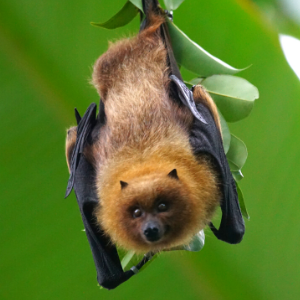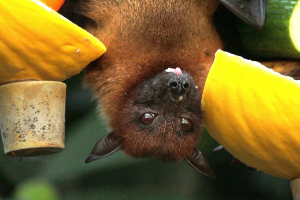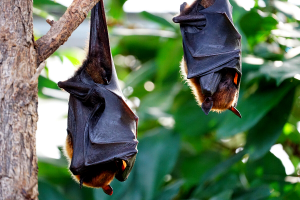Around the world, bats are cultural symbols for darkness and death, and in the western hemisphere they are even associated with characters like vampires. Many people have a fear of bats because they can carry certain diseases. However, bats play an important role in the environment, both as pollinators and as pest control, and most importantly: they are so stinking cute!
 Every year on April 17 we celebrate International Bat Appreciation Day. Since many bat species are just beginning to come out of their hibernation in April, it is a perfect time to highlight these unsung heroes of the night and share just how wonderful they are! Bats can be found on every continent of the world except Antarctica and are one of the most successful populations of mammals on the planet, after rodents. Currently there are more than 1,200 species of bat, meaning they make up about 20% of all mammals in the world. Ohio alone is home to ten different species of bats.
Every year on April 17 we celebrate International Bat Appreciation Day. Since many bat species are just beginning to come out of their hibernation in April, it is a perfect time to highlight these unsung heroes of the night and share just how wonderful they are! Bats can be found on every continent of the world except Antarctica and are one of the most successful populations of mammals on the planet, after rodents. Currently there are more than 1,200 species of bat, meaning they make up about 20% of all mammals in the world. Ohio alone is home to ten different species of bats.
Most bats are either fruit eaters or insect eaters, with a few species eating more specialty food items like nectar and small vertebrates. Of the 1,200+ species of bats, only three are “vampire” bats who survive on blood, all of whom live in Central and South America.
At the Akron Zoo, we have a colony of roughly 600 Seba’s short-tailed bats. In their natural habitat, these fruit-eating microbats live primarily in caves. Our bats can be found in our Meso-American building and are fed a diet of various fruits including apples, bananas, pears, melon, grapes and berries. Because of their high metabolism and the amount of energy burned through flying, bats have very high caloric requirements. To keep up their high energy lifestyle, these fruit bats are able to consume almost twice their body weight every single night! However, they do not pick out their fruit the way we would; bats like mushy, overripe fruit with as high a sugar content as possible. Bats are also notoriously messy eaters. To get the highest caloric benefit for their body size, bats like to suck the juices out of the ripe fruit, then spit out the pulp and seeds.
 Generally, when people think of pollinators, we think of animals like bees or hummingbirds. However, due to their unique eating habits, bats are some of the most important pollinators throughout much of the tropical world. Once bats leave in search of food at night, they look for trees containing the properly aged fruits. Their strategy is to fly down, grab a large chunk of fruit and fly off, since predators like snakes may lay in wait in fruit trees to ambush the bats. As fruit bats take fruit from one tree to another, they carry seeds and pollen much further than the tree could spread them on its own. They also tend to leave the seeds in little piles of guano, which is a very efficient natural fertilizer for growing plants. Fruit bats are responsible for pollinating over 300 species of fruit, including bananas, mangos, guava, and agave. This means that without bats, we would not have one of our country's most important resources: tequila.
Generally, when people think of pollinators, we think of animals like bees or hummingbirds. However, due to their unique eating habits, bats are some of the most important pollinators throughout much of the tropical world. Once bats leave in search of food at night, they look for trees containing the properly aged fruits. Their strategy is to fly down, grab a large chunk of fruit and fly off, since predators like snakes may lay in wait in fruit trees to ambush the bats. As fruit bats take fruit from one tree to another, they carry seeds and pollen much further than the tree could spread them on its own. They also tend to leave the seeds in little piles of guano, which is a very efficient natural fertilizer for growing plants. Fruit bats are responsible for pollinating over 300 species of fruit, including bananas, mangos, guava, and agave. This means that without bats, we would not have one of our country's most important resources: tequila.
While all bats have fairly decent nocturnal vision, echolocation can also be helpful for catching small, fast-moving insects in the middle of the night. Echolocation is used by making a very high pitched clicking noise in the bat’s larynx. This sound travels until it hits an object, bounces back, and returns to the bat’s super-sensitive ears. This location mechanism is accurate enough to pinpoint a mosquito in mid air due to bats’ ability to produce up to 200 clicks per second. Seba’s short-tailed bats, however, don’t need to use their echolocation to find their food, since bananas don’t run away very quickly. Instead, they use their echolocation primarily to find their way through the caves that they sleep in during the day.
 Unfortunately for us, bat numbers around the world are on the decline. The IUCN Red List considers roughly one-third of bat species to be threatened or not sufficiently studied. Deforestation, disease and invasive predatory species are all significant problems for bat populations. Another issue is misinformation. People in many countries still believe that bats are evil, or incorrectly identify them as vampire bats. This has resulted in bat colonies being eradicated in massive numbers.
Unfortunately for us, bat numbers around the world are on the decline. The IUCN Red List considers roughly one-third of bat species to be threatened or not sufficiently studied. Deforestation, disease and invasive predatory species are all significant problems for bat populations. Another issue is misinformation. People in many countries still believe that bats are evil, or incorrectly identify them as vampire bats. This has resulted in bat colonies being eradicated in massive numbers.
So what can we do to help bats? There are some things we can do for the bats in our own backyards, like building bat boxes. Because many bats will roost in dead trees, building bat boxes gives bats a place to sleep, and helps to provide natural pest control for your yard. One little brown bat is capable of eating up to 1,000 mosquitos in a single hour! You can also donate to organizations who contribute to bat conservation, or donate to the Akron Zoo to help us provide food and care for our bat species!
